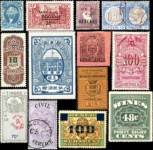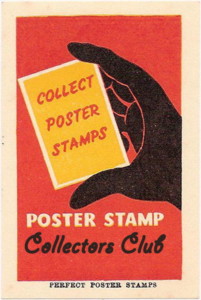What are Cinderellas?
by Ray Petersen
The simplest definition of a cinderella is any stamp or stamp-like item that is not what most collectors would consider to be a postage stamp.
Historically, the only items that were allowed in internationally sanctioned stamp exhibits were traditional postage stamps.
But, even before 1900, there were other stamp-like items being published – and used for advertising and publicity & propaganda purposes. There were also more traditional looking stamps used as evidence of the payment of taxes or other fees. And there were postage stamps issued by municipalities and private companies for pre-payment of shipping fees. All of these, and more, were avidly collected, but still excluded from competitive exhibiting.
So, in the 1950s, in the UK, a group of collectors of these philatelic oddities, got together to form a club. They determined that these stamp-like labels, stickers, and stamps, which were frequently as beautiful as the best the postage stamp world had to offer, were like the fairy-tale princess known as Cinderella. She was of great beauty, but was not allowed to attend the royal ball, just as these beautiful stamps were not allowed in competitive exhibiting. So, this group of collectors called the items “Cinderellas” and founded the Cinderella Stamp Club, which is still going strong today. In keeping with the Cinderella theme, they also hold an annual “Glass Slipper Competition”.
Exactly what type of item is considered to be a cinderella is very flexible. Over time, the rules for competitive international exhibiting have become somewhat relaxed in terms of what may be included, and many mainstream catalogs now list items which were once considered to be unworthy of inclusion. My own preference is to be more inclusive than exclusive. Just because something is listed in a catalog somewhere should not exclude it from being considered a cinderella.
These definitions, are only a guideline, and are based on the authors opinion.
Local or Carriage Stamp
A stamp that pays for postage within a certain area only, including privately produced issues as well as government issues. Locals must be accompanied by a regular postage stamp if the letter is to travel outside of the local area.
Private & Semiofficial Airmail, Rocket Mail, Railway & Express company, and Shipping company stamps are all types of Locals, but carriage of the letters was restricted to a specific mode of delivery.
Poster Stamps
The easy definition of poster stamps is any stamp (non-denominated) created to advertise or commemorate a product or event. The evolution of the poster stamp is that it was originally a miniature version of a poster issued to advertise or commemorate a product or event. According to Charles Kiddle: “The main characteristic of the true poster stamp is integrity of design”. What this means is that in order for the poster stamp to effectively convey its intended message, then the design and color scheme must be carefully chosen in order that such a small piece of paper can catch one’s eye and get the message across. The bottom line is that in some cases the poster stamps worked and in some cases they did not. However, they are all collectible for one or more reasons. Poster stamps tend to be highly topical in nature, and an individual stamp may appeal to several collectors for different reasons. Generally speaking, poster stamps now include any advertising stamps as well as exhibition stamps (commercial as well as philatelic), patriotic and political stamps, military propaganda stamps, tourism promotional stamps and other similar stamps. A very popular area of poster stamps is artist-signed (or identified) poster stamps. While many poster stamps show a signature (or monogram), even more do not, making it a challenge to discover the artist who designed a particular stamp. Many of the world’s most well-known graphic artists of the late 19th and early 20th century designed poster stamps, and there are many collectors who specialize in specific artists or schools of art. Known in Germany as Reklamemarken, in France as Vignettes, in Denmark as Samlermærke.
Charity Stamps
As the name implies, these are stamps issued and sold by charitable organizations to raise funds to aid and advance their goals. Sometimes called “Seals” as in Christmas Seals, Easter Seals, etc. There is some crossover between this group and the poster stamp group in the area of Military propaganda issues. During the two World Wars (primarily) there were many stamps issued ostensibly to raise funds for charitable works such as rebuilding war-ravaged cities and towns or to aid families of veterans. Many of these issues were, in fact, bogus fund-raisers and so they fit more into the category of poster stamps even though they are denominated and appear to be charity issues.
Labels
The term “labels” is sometimes interchanged with “stamps” or “seals”, but a label is best described as a (usually) imperforate sticker that is applied to a product package to inform one as to the contents of the package. Labels can also include “baggage labels” which are usually large, and were intended to be placed on luggage, to advertise a hotel or mode of transport.
Seals
Again, a term sometimes interchanged with “stamps” or “labels”, but in the purest sense a seal is evolved from the impressions made on hot wax which was dripped onto a letter flap to seal the letter. Seals are usually now called “letter seals” and are usually round, with or without scalloping on the edges, and may be embossed. These were most commonly used by various governmental departments, but they were also used by companies to advertise their businesses, as well as some commemorative examples.
Etiquettes
These are usually small, rectangular “par avion”, “air mail”, “express” or registration stickers. The air mail etiquettes are quite numerous, and were issued by governments, airlines, and private printing companies. Generally, the ones issued by governments or private printers are the most utilitarian in nature, but some of the airline issued etiquettes are pictorial, often depicting airplanes.
Toy Stamps
Toy stamps were produced primarily for children, either by themselves or as part of a game, in which the children could set up a make-believe post office. Always smaller than traditional postage stamps, some toy stamps mimic actual postal issues, while others are complete fantasies in design. Toy post offices also often contained the other accoutrements commonly found in a real post office, such as cancelers, postal stationery, postal forms, and even post office signs. There have even been some toy postage stamps issued as advertising media. Known in Germany as Kinderpost, in France as Post Enfantine, in Denmark as Børnefrimærker or Legetøjsfrimærker.
(The sample image shown is comprised of Danish issues)



































